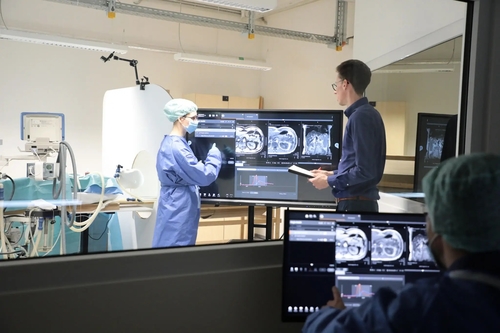NEWS
Science Insight: Usability Show Case einer MRT-geführten Leberbiopsie
Das Usability-Labor des Forschungscampus STIMULATE ist das Ergebnis einer fruchtbaren Zusammenarbeit zwischen Wissenschaft, klinischer Anwendung und wirtschaftlichen Verwertungsanforderungen für bildgeführte Therapieansätze. Gemeinsam haben die STIMULATE-Partner USE-Ing. GmbH, Otto-von-Guericke-Universität Magdeburg und Medizinische Hochschule Hannover das Usability Labor als spezialisierte Umgebung entwickelt, um den besonderen Herausforderungen der interventionellen Radiologie gerecht zu werden, den klinischen Workflow zu optimieren und sowohl die Benutzungserfahrung für medizinisches Personal als auch die Gesundheitsversorgung zu verbessern.
Das Ergebnis dieser Bemühungen ist das Usability Labor mit dem Schwerpunkt interventionelle Magnetresonanztomographie, bestehend aus einem simulierten Interventionsraum mit einem interaktiven Modell eines MRT-Geräts, einem MRT-Kontrollraum und einem Beobachtungsraum zur Überwachung und Aufzeichnung der simulierten Arbeitsabläufe. Für die anvisierte Analyse des Workflows – sowohl von einzeln agierenden Personen als auch ganzen klinischen Teams – sind neben Audio- und Videoaufzeichnungen aus bis zu sechs Perspektiven auch Analyseoptionen von Eye- und Motion-Tracking-Daten implementiert.
Eine erste erfolgreiche Erprobungsstudie erfolgte in Form einer simulierten MRT-gestützten Entnahme von Leberbiopsien durch drei interventionelle Radiologie-Teams (Radiolog:innen und medizinisch-technische Radiologieassistenz), welche durch die Kooperation der STIMULATE-Partner Universitätsklinikum Magdeburg, der BEC GmbH und der IGEA S.p.A. ermöglicht wurde. Dabei wurden die jeweils zweiköpfigen Teams über die zu simulierende Intervention informiert und während der Durchführung audiovisuell sowie mittels Blick- und Bewegungstracking überwacht, um weiterführende Informationen z.B. zur Aufmerksamkeitsfokussierung und zu technischen Ergonomiemerkmalen zu erhalten.
Der Erfolg des Show Cases zeigt, wie wichtig die Zusammenarbeit zwischen Industrie, Klinik und Wissenschaft ist, um die Sicherheit und Effizienz der am Forschungscampus entwickelten minimal-invasiven Technologielösungen weiter zu verbessern. Durch derartige Erprobungen der Usability von medizintechnischen Prototypen können somit ein Beitrag für eine sowohl patientenschonenden als auch anwenderzentrierte Medizin der Zukunft geleistet und Innovationen auf ihre praktische Anwendbarkeit überprüft werden.

Bilder/Pictures: Arbeitsabläufe während der Usability Studie Leberbiopsie im STIMULATE Usability Labor. Quelle: USE-Ing. / Workflows during the liver biopsy usability study in the STIMULATE usability laboratory. Source: USE-Ing.
Weiterführender Artikel/Related Article: A glimpse into the world of human-centered technology development - Evaluation of the STIMULATE Usability Lab
Science Insight: Usability show case of an MRI-guided liver biopsy
The usability laboratory at the Research Campus STIMULATE is the result of a fruitful collaboration between science, clinical application and the commercial utilisation of image-guided therapy approaches. Together, the STIMULATE partners USE-Ing. GmbH, Otto-von-Guericke-University Magdeburg and Hannover Medical School have developed the laboratory as a specialised environment to meet the particular challenges of interventional radiology, optimise the clinical workflow and improve both the user experience for medical staff and patient care.
The result of these efforts is the usability laboratory focussing on interventional magnetic resonance imaging, consisting of a simulated intervention room with an interactive model of an MRI device, an MRI control room and an observation room for monitoring and recording the simulated workflows. In addition to audio and video recordings from up to six perspectives, analysis options for eye and motion tracking data are also implemented for the targeted analysis of the workflow - both of individuals and entire clinical teams.
The first successful trial study took the form of a simulated MRI-assisted liver biopsy performed by three interventional radiology teams (radiologists and medical-technical radiology assistants), which was made possible by the cooperation between STIMULATE partners University Hospital Magdeburg, BEC GmbH and IGEA S.p.A. The teams of two were informed about the intervention to be simulated and monitored during the procedure using audio-visual and gaze tracking. The two-person teams were each informed about the intervention to be simulated and monitored audiovisually and by means of gaze and movement tracking during performance in order to obtain further information, e.g. on focussing attention and technical ergonomic features.
The success of the showcase demonstrates the importance of collaboration between industry, clinics and science in order to further improve the safety and efficiency of the minimally invasive technology solutions developed at the research campus. By testing the usability of medical technology devices in this way, a contribution can be made to both patient-friendly and user-centred medicine of the future and innovations can be tested for their practical applicability.